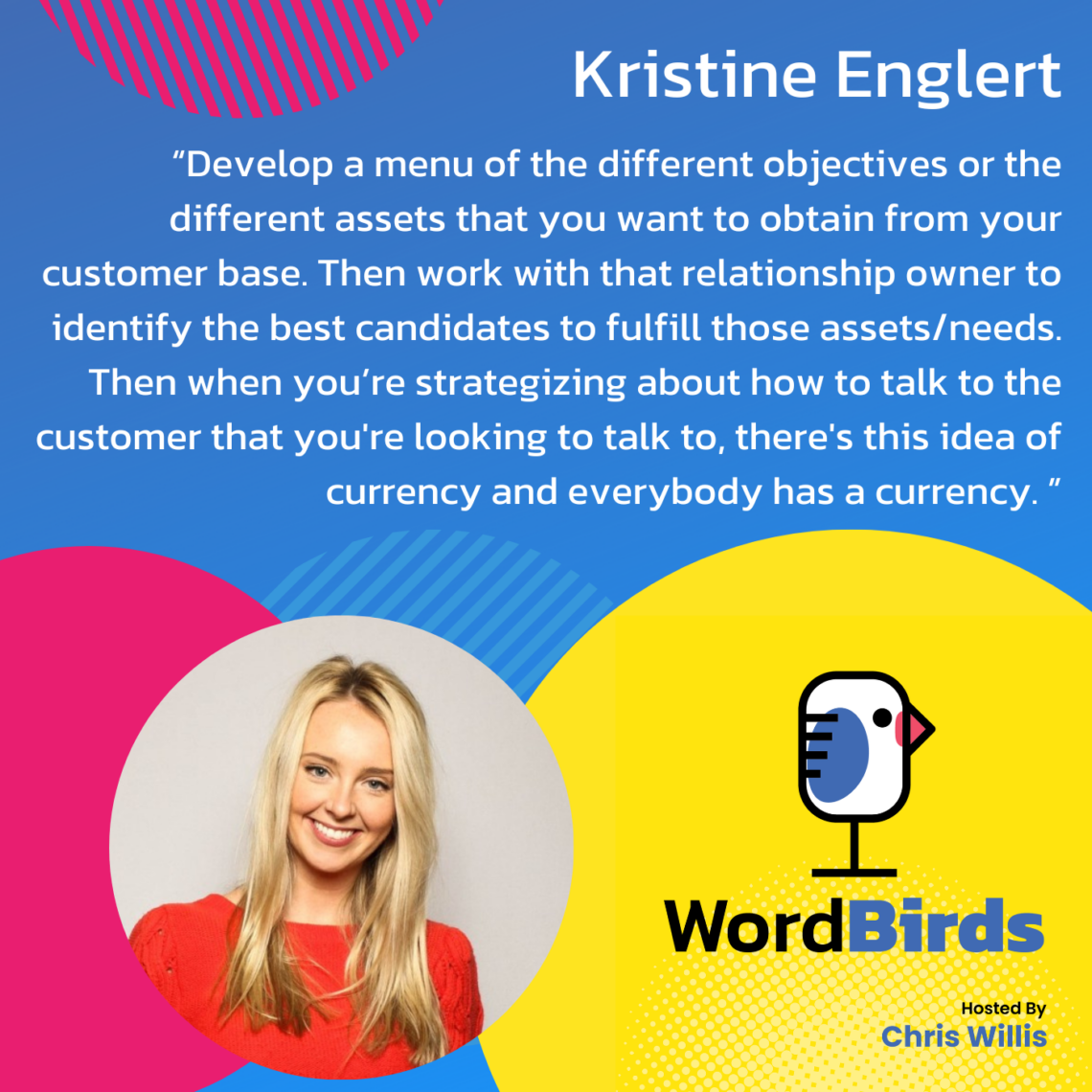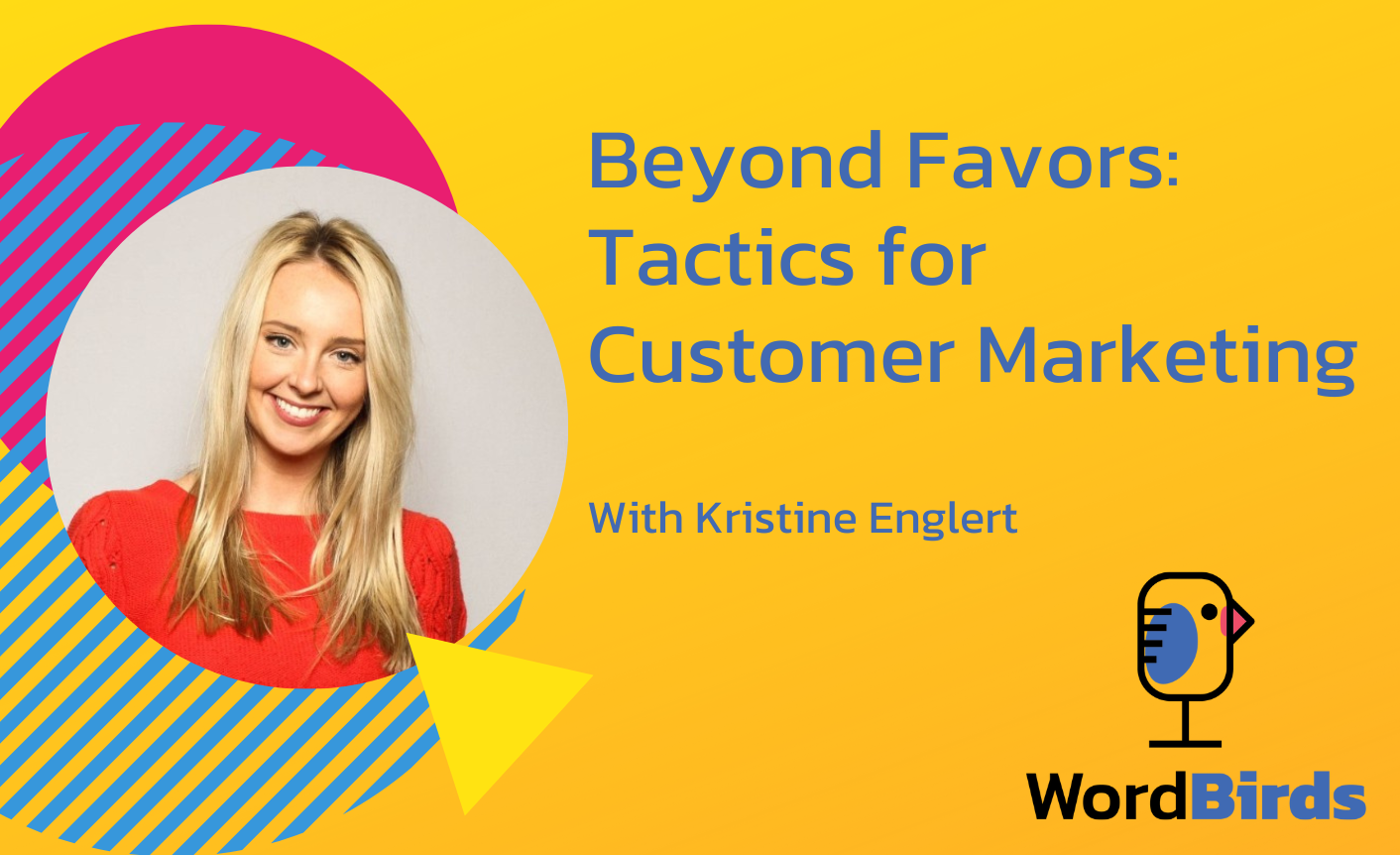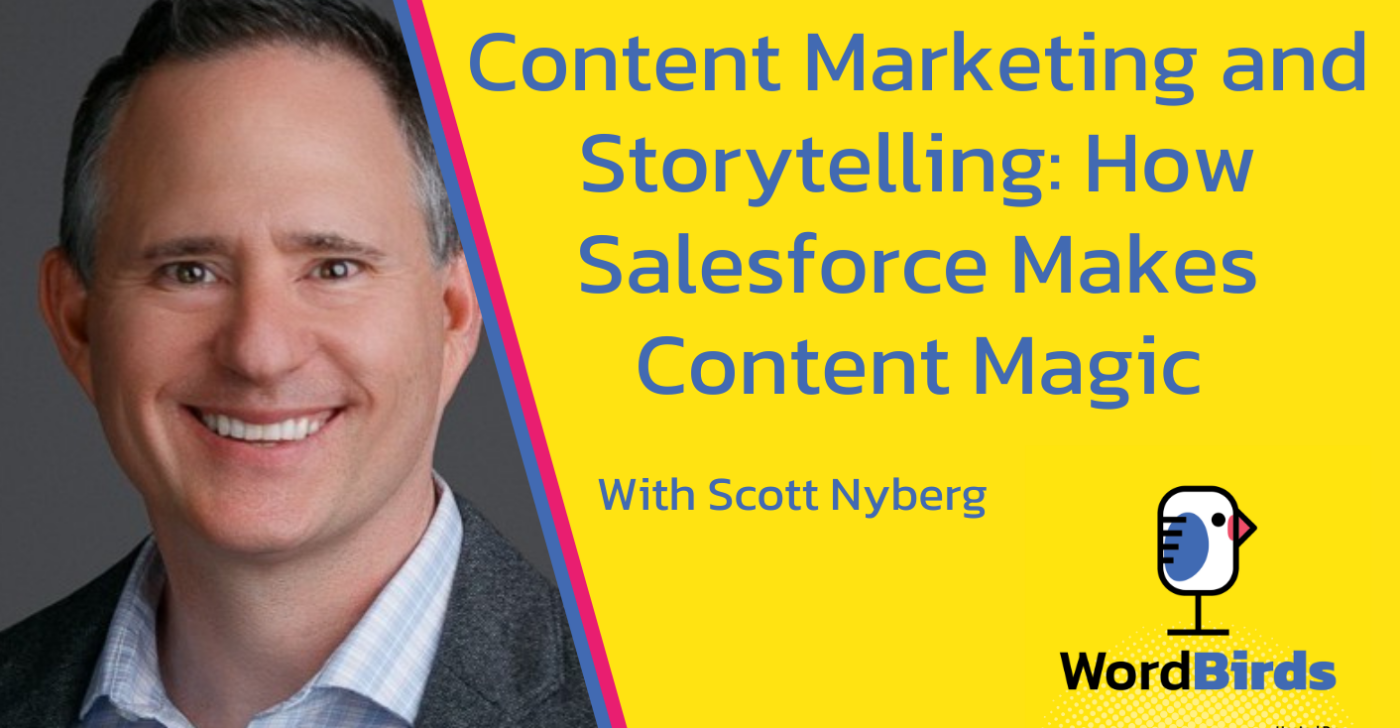In this episode, we’re thrilled to have Kristine Englert, Director of Customer Marketing at Mirakl, sharing her wealth of experience in the dynamic realm of marketing. Our host, Chris, dives into Kristine’s journey, shedding light on impactful campaigns that transcend marketing channels.
Kristine kicks off by unveiling the secret behind her most successful campaign — a data-driven initiative that became a versatile asset across various marketing facets. Emphasizing the pivotal role of understanding your audience, after all it’s the linchpin between success and failure in marketing.
We discuss the intricacies of marketing with customers rather than just to them. Kristine unfolds the art of showcasing the mutual benefits of collaboration, debunking the notion of customers doing marketers a favor. Drawing from her experiences at Mirakl and Perfecto, Kristine shares anecdotes of both triumphs and learning opportunities, including the strategic blunder of misaligned campaigns and the lessons learned. After all, customer marketing should also benefit the customer too!
Join us as Kristine unravels the tactics behind creating content that resonates beyond marketing, the importance of customer-centricity, and the strategies to forge lasting relationships for mutual growth. This episode promises valuable insights into the evolving landscape of customer marketing strategy and the art of leveraging collaboration for enduring success.
Watch the episode
Listen to the episode
Read the full episode transcript
Hello Kristine and welcome to WordBirds! So excited to have you here.
Hi, how are you?
Fantastic. For those of you that don’t know, Kristine and I work together at Perfecto. We’ve had several Perfecto guests this season. We had Gidi in episode one, we had Flora midway through the season, and we’re going to be wrapping up with Kristine Englert Skinner who currently works at Mirakl.
Yes, the director of customer marketing at Mirakl.
Fantastic. Very exciting. Let’s jump right into the quick fire question. So what’s your best and most successful campaign so far?
So I think that the best, most successful campaign that I’ve worked on thus far has really been one that could be used in all different facets of marketing — and that’s why. What the campaign looked like is: I created an asset with a cross-functional team that analyzed tens of millions, maybe a hundred million, pool of customer data and anonymized it. And built this campaign that really intended to give the market, give the industry some information about consumers that they didn’t have, that only we had.
So that doesn’t feel totally groundbreaking in the way that we thought about the strategy there, but the way that we were able to execute it really made it a super successful campaign. We were able to extract a lot of PR and thought leadership from it. We were able to really develop a strong demand gen engine from it and take that even one step further. We were able to really work with business development and the sales team to send them some information that they could really leverage to target their prospects, get them engaged, give them a little information about how consumers were valuing their competitors, and really draw them in there using some positive things about their competitors.
It’s just something that could be used across really all marketing channels.
Exactly. Then from that, we saw so much success with an initial release of it that we were able to update it every year. It became an industry piece that analysts are looking forward to every year and we could riff on the new findings every year as well.
I truly believe that your customers want to market with you. And tapping into that currency is really going to help you find them. Click To TweetInteresting. And that’s been a recurring theme over this season. I don’t want to derail the quick fire, but a lot of people have talked about the ability to create a content piece that over time attracts way more than new leads and customers. But brings in the media, brings awareness to the business. So covering that multi-channel approach takes one thing and provides huge value to the entire organization.
And it’s something that we could cite throughout the year, reference back to, continue to give it life. And then continue to cite the following year when we had new details lined up in things like speaking opportunities or press articles. So we really squeezed a lot of juice out of it.
Well that sounds very exciting. Now I wanna know what’s the worst one you’ve done. Because that’s pretty cool.
Sure, so the worst one, I feel embarrassed, but the worst one is at the same organization. We worked with a lot of retail prospects, a lot of retailers, and over the summer, we did some campaigns about back to school to the prospect base. And in the fall, we did some campaigns about the upcoming holiday season, Black Friday, to this base as well. And do you know when retailers start planning for Black Friday in the holiday season? Because it’s not in the fall — it’s in February, like nine months, 10 months earlier.

So I’d say the worst campaigns were big learning opportunities. But, not being totally aligned to the customer calendar or our intended audience calendar and not knowing them well enough to really make sure that we’re giving them the information that they need when they need it.
Thanks so much, but we’ve been done with this for six months.
Yes. Oh, you want to talk about implementing something? We’re about to go into code phrase. You should have talked to us on the first of the year!
So out of the two of those, where were the learnings? It sounds like that.
I definitely think that one. Know your audience and know their intricacies and their details. I think each audience pillar may have something like a different type of calendar or different needs and I wouldn’t blanket message across all different verticals.
Amazing, amazing. When you think about the things that you’ve done and your best and your worst, again there’s a lot of creating that major piece of content that goes beyond just marketing to be part of the personality of the business.
I don’t know if you were still at Perfecto when Carlo Cadet created the magazine around devices, but that for us at Perfecto provided the sales team, I mean, we used it as marketing, it generated leads, people signing up for it. We used it as webinar bait, essentially, and had thousands of people register for our webinars, and our salespeople used it, just like you said, to be able to tell a story in front of a customer. So what does 30% test coverage look like today on the devices in market and that goes beyond being a marketing piece to how a company goes to market. It changed the way that Perfecto sold software and that I think that’s I mean it speaks to that successful campaign idea that you’re talking about.
Yes, it definitely is an up level from a content strategy or a demand strategy and becomes a lot bigger.
So today you’re at Mirakl, your customer marketing community. One of the reasons that I wanted to talk to you is that there’s multiple ways that you can do that job. There’s obviously marketing to the customer and that customer lifecycle approach, but there’s also marketing with the customer.
There's definitely a matter of trying to educate your peers and the relationship owners on that favor mindset as well. Click To TweetLet’s talk about marketing to the customer first, because I wanna spend more time on marketing with the customer. What are you seeing? What’s the best way to reach your customer? Obviously they’re already engaged with your organization. What do they need to see? What do they need to know to be able to manage customer retention, for example?
Sure, so we’re always keeping in touch with our customers on upcoming product announcements or different innovations that are coming down the line. I think there’s a group of customers, the best way to get them involved is to get them involved early, get them involved in the testing cycles, get them involved even in the design iterations, things like that. There’s definitely a group of people who are interested in things like that.
I think that when it comes down to delivering consistent content for customers, they still want to see other customer stories and they still want to see the thought leadership that you might be more focused on in the demand cycle. So don’t forget your customers when you’re building those campaigns, building those programs. Because I think that any touchpoint you have that’s gonna continue to inspire the customer is going to keep them around longer, keep them engaged, and make them more willing to bring that forth to other departments within their organization or help them elevate the projects that they’re doing. If they can say, look at this work from this amazing partner, they’re also working with X, Y, and Z customers. Or they’re also leading the market with X, Y, and Z research. Don’t forget your customers, they want to see that too.
From a product communication standpoint, are you engaged with the product organization to help them with future product direction and product north star? Because I think that’s something that helps your job tremendously.
For us, our customers are gaining efficiency through the editorial process. And our product north star is about getting to 90% automation of the process, so driving much more efficiency. So the conversation is always, if you’re at 50% today, the next thing we’re gonna do is gonna get you to 60% and 70%. And that’s not necessarily the connection that marketing has with product in an organization. Sometimes product is building something that falls outside of the pathway of value that customers are experiencing. So do you get to spend time? Interfacing with product to make sure that the things that they’re doing drive your customer journey.
I think the number one thing for an organization who's either thinking about a developing customer marketing team or customer marketer themselves is to have the mindset that you are not asking the customer to do you a favor. Click To TweetSo there are two things that we’re doing on the customer marketing side that are related to that. One is the customer marketing team is really integrated with the product marketing team and the customer success team. We call our customer success managers “business consultants,” and we’re all very integrated as it relates to forthcoming products or customers who are beta testing products or announcements around new products that involve customers. So there’s a synergy between those three teams that I think help drive towards the north star. I definitely don’t want to take credit and say that we are the main driver there, but there’s that trifecta who’s working together on at least the go-to-market side of things.
Then we also work closely with a number of people on the product team to organize user advisory boards for the product team a couple of times throughout the year because they aren’t interfacing with customers as frequently as we are. So, we hold a lot of those relationships and can make those connections to the product team. And that’s been really helpful, I think for the customer and for the product team as well.
So one of the things that you talked about was fueling all these initiatives with other customers. In the time that we worked together and in my time here, the most difficult thing is getting customers to participate in marketing of any kind. How are you building relationships with customers to get those stories from them?
So this is my favorite part of my job. We have the pillar of marketing to your customers, but also this pillar of marketing with our customers. And at Mirakl, the customer stories that we develop are really central pieces to a lot of our marketing content, if not all of our marketing content. So it’s a really important piece of the puzzle. I think the number one thing for an organization who’s either thinking about a developing customer marketing team or customer marketer themselves is to have the mindset that you are not asking the customer to do you a favor. I think that going into it thinking you’re also doing them a favor and that this is something that can really benefit the customer in the long run as well is really the first thing that you need to have in order to approach this whole concept of customer marketing strongly.
We have the pillar of marketing to your customers, but also this pillar of marketing with our customers. Click To TweetI find that oftentimes customer success, for example, who has a relationship with the customer has a lot of concerns, let’s say, about letting us talk to the customer. It’s never the right time. There’s always something, there’s a ticket in right now, we need to be working on the software, we’re fixing something for them. This isn’t the right time to talk to the customer. Do you listen to that or do you have the relationship with your customers?
That’s a good question. It depends. I think one of the main paths to success is working through the relationship owner. If there’s no one with a strong relationship at a certain account, then I’ll happily introduce myself and become the relationship owner. There’s definitely a matter of trying to educate your peers and the relationship owners on that favor mindset as well. You’re not asking them for a favor. You’re doing them a favor is really the flip that I like to call it. I think it takes a reminder every now and then. But all somebody needs to see from a customer success standpoint or from a relationship owner standpoint are a couple of accounts who have a spokesperson has really benefited from it and they’ll understand.
So get actionable. How do you get them excited about this? I’ve heard you say now a couple of times, this isn’t a favor, it’s a benefit. How do you make them believe that? I believe you. I remember we did this at Perfecto and had a whole document that overviewed the benefits to the customer. But I’m also a marketing person and I know that was a little bit self-serving. How do you make this worth your time?
So I guess tactically speaking, one, develop a menu of the different objectives or the different assets that you want to obtain from your customer base. Then work with that relationship owner to identify the best candidates to fulfill those assets/needs. Then when you’re strategizing about how to talk to the customer that you’re looking to talk to, there’s this idea of currency and everybody has a currency.
You can get someone to say yes if you strike their currency and their currency could be something like they want self-promotion. They’re trying to build their personal brand. So they might be really interested in doing some PR where they’re interviewed and they can elevate themselves personally. They might be interested in something that’s related to thought leadership across the industry so that they can elevate their project a little bit. Maybe they have some hiring sprees coming up and that’s something that they can use across the industry to generate interest with the hiring pool. Another currency could be, like I mentioned, getting people involved in testing programs, beta programs early and often. They might want to have influence. They might have some ideas that your team might not have thought of yet, and they just want somebody to listen, they wannabe a part of the actual creation. That’s an important currency that we see all the time.
One is the customer marketing team is really integrated with the product marketing team and the customer success team. Click To TweetSo understanding a little bit more about who the individual is and what’s going to motivate them will really help you get them to agree to the project. Then separately, another tactic that’s worked pretty well recently, for me, has been to learn a little bit about that individual prior to actually the sales cycle. So you’re working with your salesperson, writing in the contract, these specific things that you want, these assets that you want the customer to help develop. Oftentimes they still have that currency, it’s just now in writing that that’s something that they’re gonna complete with you.
How often does that get struck from the contract though?
Honestly, less than I would think. Maybe go in with a foot and door approach and scale it back. Less frequently than I would think.
Amazing, amazing. This continues, especially in B2B software, to be a huge issue. When you’re selling to the enterprise, it only gets worse because it’s not just Bill at this company wants to self-promote, but Bill needs to take the hill with the PR organization inside a major corporation to get approval to do this. Anything’s possible to your point. But in this case, Bill needs to believe it and then go and lead this process because we can’t do that for him. He needs to do that.
Then I volunteer to speak with the PR team and even develop them a playbook about what we’re going to do. So one, it’s as easy as possible with examples. So it’s as easy as possible for the PR team to understand the objective and what’s actually needed from their side. And then they’re actually speaking to another communications PR professional as well. So they’re speaking to their peers.
I totally see the connection between the beginning of your career and where you are now because Kristine started in PR and this makes a lot of sense. All of it comes back around, so you need to know how to communicate with the people. Okay, I get it.
This is the time in the show, my favorite part of the show, where we go over the PSOTD, or the Provocative Statement of the Day. It’s a position that you hold that you don’t know that everybody holds, but that helps you to define a little piece of the world. What’s your provocative statement of the day?
I’ve mentioned it a couple of times, but I truly believe that your customers want to market with you. And tapping into that currency is really going to help you find them.
Know your audience and know their intricacies and their details. Click To TweetI feel like everybody that’s involved in customer marketing just heard that statement and was like, that’s absolutely not my experience. So that qualifies as a fantastic Provocative Statement of the Day.
The thing is that you gave us the steps and the tactics to be able to go out and do that. So I think if you’re listening to this today, sitting at your desk somewhere in the world, thinking I can’t get my customers to do the things I want. You have the groundwork now. You’ve been given the steps and the overview and now your position should be that you’re not doing a favor. They’re not doing you a favor. You’re actually helping them. You find that currency and you drive this forward for that person, it’s good for them and it’s good for you. It doesn’t have to be a one-way street.
I think that’s a phenomenal approach to adopt this position and drive forward your customer marketing and especially that piece with the marketing with your customer. That’s fantastic. Christine, thank you so much for being on the show. I really enjoyed this. I’d love to have you back in the future.
Thanks, Chris.
Important links
- Kristine Englert – LinkedIn
- Mirakl
- WordBirds – LinkedIn
- WordBirds – Home page



